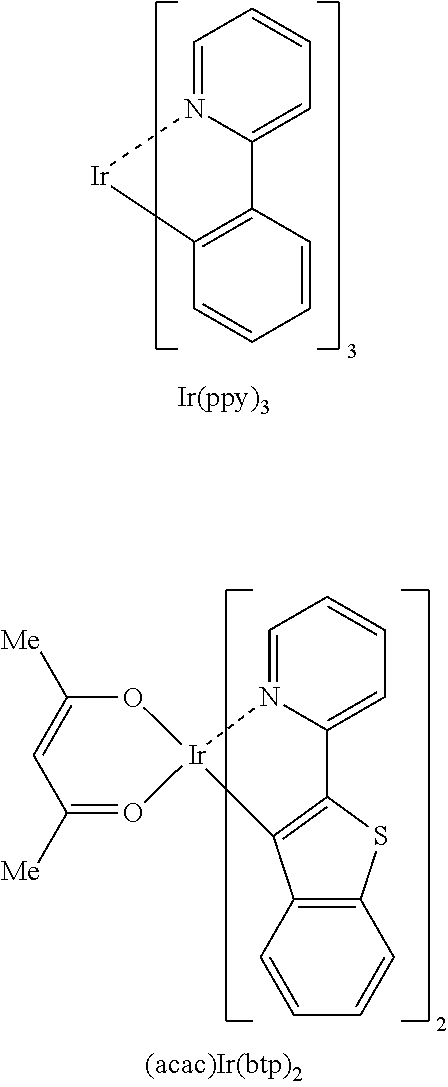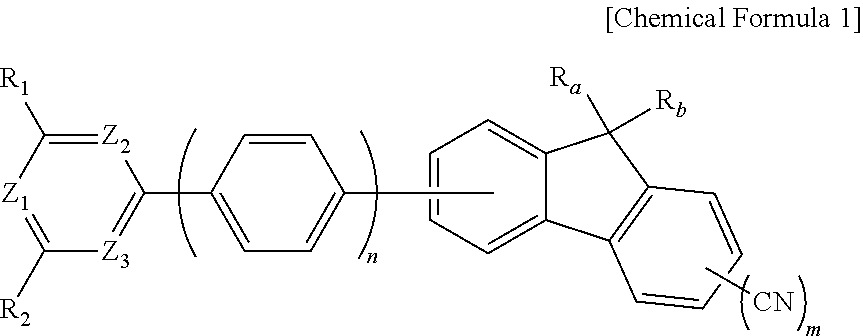Organic compound and organic electroluminescent device using same
a technology of organic compounds and electroluminescent devices, which is applied in the direction of luminescent compositions, organic chemistry, chemistry apparatuses and processes, etc., can solve the problems of poor thermal stability and the inability to meet the requirements of organic el devices using such conventional materials, and achieve excellent heat resistance, electron transport ability and luminescent characteristics, and improve the effect of luminescent characteristics, life span and efficiency
- Summary
- Abstract
- Description
- Claims
- Application Information
AI Technical Summary
Benefits of technology
Problems solved by technology
Method used
Image
Examples
preparation example
Preparation Example 1
Synthesis of FC-1
[0094]
Synthesis of 7-bromo-9,9-dimethyl-9H-fluorene-2-carbonitrile
[0095]50 g of 2-bromo-7-chloro-9,9-dimethyl-9H-fluorene and 18 g of copper cyanide were added to 250 ml of NMP, and the mixture was stirred under TLC monitoring at 120° C. After completion of the reaction, the mixture was cooled to room temperature, 300 ml of ice water was added thereto. A resultant solid was collected by filtration, neutralized with an aqueous ammonia solution, and extracted with chloroform. The extracted solution was concentrated under reduced pressure and recrystallized using ethanol, and thus a target compound 7-bromo-9,9-dimethyl-9H-fluorene-2-carbonitrile (32 g, yield 48%) was obtained.
[0096]1H-NMR: δ 8.08 (d, 1H), 7.80-7.79 (m, 2H), 7.72 (s, 1H), 7.63 (d, 1H), 7.55 (d, 1H), 1.69 (s, 6H)
Synthesis of FC-1
[0097]30 g of 7-bromo-9,9-dimethyl-9H-fluorene-2-carbonitrile, 26 g of 4,4,4′,4′,5,5,5′,5′-octamethyl-2,2′-bi(1,3,2-dioxaborolane), 7.0 g of Pd(dppf)Cl2, a...
preparation example 2
Synthesis of FC-2
[0099]
Synthesis of 7-chloro-9,9-dimethyl-9H-fluorene-3-carbonitrile 7-chloro-9,9-dimethyl-9H-fluorene-3-carbonitrile (31 g, yield 48%) was prepared in the same manner as in Preparation
[0100]Example 1, except that 6-bromo-2-chloro-9,9-dimethyl-9H-fluorene was used instead of 2-bromo-7-chloro-9,9-dimethyl-9H-fluorene in step 1 of Preparation Example 1.
[0101]1H-NMR: δ 7.93 (d, 1H), 7.80 (d, 2H), 7.72 (s, 1H), 7.68 (d, 2H), 7.63 (d, 1H), 7.55 (d, 1H), 1.69 (s, 6H)
Synthesis of FC-2
[0102]FC-2 (23 g, yield 64%) was prepared in the same manner as in Preparation Example 1, except that 7-chloro-9,9-dimethyl-9H-fluorene-3-carbonitrile was used instead of 7-bromo-9,9-dimethyl-9H-fluorene-2-carbonitrile in step 2 of Preparation Example 1.
[0103]1H-NMR: δ 7.98 (d, 1H), 7.78-7.75 (m, 2H), 7.50-7.44 (m, 3H), 7.24 (d, 1H), 1.69 (s, 6H), 1.20 (s, 12H)
preparation example 3
Synthesis of FC-3
[0104]
Synthesis of 2-bromo-9,9′-spirobi[fluorene]-7-carbonitrile
[0105]2-bromo-9,9′-spirobi[fluorene]-7-carbonitrile (34 g, yield 50%) was prepared in the same manner as in Preparation Example 1, except that 2,7-dibromo-9,9′-spirobi[fluorene] was used instead of 2-bromo-7-chloro-9,9-dimethyl-9H-fluorene in step 1 of Preparation Example 1.
[0106]1H-NMR: δ 8.08 (d, 1H), 7.89 (d, 2H), 7.79-7.72 (m, 3H), 7.63 (d, 1H), 7.55 (d, 1H), 7.45 (d, 1H), 7.28-7.25 (m, 4H)
Synthesis of FC-3
[0107]FC-3 (25 g, yield 63%) was prepared in the same manner as in Preparation Example 1, except that 2-bromo-9,9′-spirobi[fluorene]-7-carbonitrile was used instead of 7-bromo-9,9-dimethyl-9H-fluorene-2-carbonitrile in step 2 of Preparation Example 1.
[0108]1H-NMR: δ 8.07 (d, 1H), 7.87 (d, 2H), 7.79-7.72 (m, 3H), 7.62 (d, 1H), 7.53 (d, 1H), 7.44 (d, 1H), 7.28-7.25 (m, 4H), 1.20 (s, 12H)
PUM
| Property | Measurement | Unit |
|---|---|---|
| temperature | aaaaa | aaaaa |
| current density | aaaaa | aaaaa |
| driving voltage | aaaaa | aaaaa |
Abstract
Description
Claims
Application Information
 Login to View More
Login to View More - R&D
- Intellectual Property
- Life Sciences
- Materials
- Tech Scout
- Unparalleled Data Quality
- Higher Quality Content
- 60% Fewer Hallucinations
Browse by: Latest US Patents, China's latest patents, Technical Efficacy Thesaurus, Application Domain, Technology Topic, Popular Technical Reports.
© 2025 PatSnap. All rights reserved.Legal|Privacy policy|Modern Slavery Act Transparency Statement|Sitemap|About US| Contact US: help@patsnap.com



